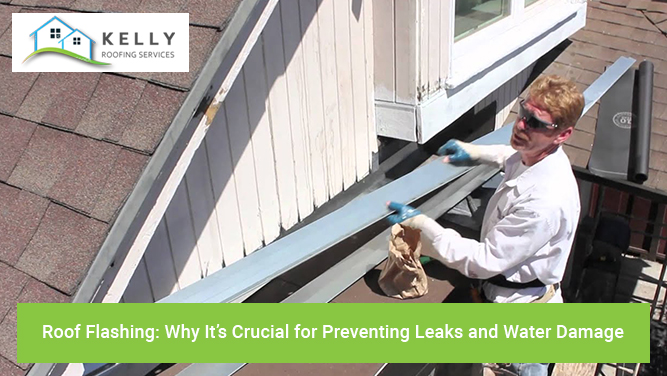Roof Flashing: Why It’s Crucial for Preventing Leaks and Water Damage
Roof flashing is an essential part of any roofing system. It helps prevent leaks and water damage in buildings. Roof flashing is typically made from metal, such as aluminum or galvanized steel. It is installed around joints and edges of roofs to seal them from water entry. This is especially important in areas where two surfaces meet, like chimneys, vents, and skylights. Without proper flashing, water can easily seep through these gaps and cause significant damage to a building’s interior and structure.

Prevents Water Entry
One of the main reasons roof flashing is crucial is that it prevents water from entering your home. Without flashing, water can easily find its way into your home through gaps and seams. This can lead to leaks that cause serious damage to walls, ceilings, and floors. Flashing acts as a barrier that seals these vulnerable areas. It ensures that water is kept outside where it belongs.
Water entry can lead to mold growth, which can be harmful to your health. Mold thrives in damp environments, and once it starts growing, it can spread quickly. This can cause respiratory problems and allergies. By keeping water out, flashing helps maintain a dry and healthy indoor environment.
Additionally, water entry can weaken the structure of your home over time. Water can cause wood to rot and metal to rust. This can compromise the strength and stability of your roof and walls. Proper flashing helps protect your home from these kinds of damage, ensuring that it remains strong and safe for years to come.
Protects Roof Edges
Roof edges are particularly vulnerable to water damage. Rainwater can easily run off the edge of the roof and seep into the building if not properly managed. Flashing helps protect these edges by guiding the water away and preventing it from entering the building. This is especially important during heavy rains or storms, when large amounts of water can accumulate on the roof.
The edges of the roof are also exposed to wind and weather. Over time, this exposure can cause wear and tear, leading to gaps and cracks. Flashing helps reinforce these edges, making them more resistant to the elements. This prolongs the lifespan of the roof and reduces the need for repairs.
In addition to protecting the roof itself, flashing also protects the walls and foundation of the building. Water that runs off the edge of the roof can pool around the base of the building, leading to foundation damage. Flashing helps direct water away from the building, reducing the risk of such damage.
Seals Joints and Valleys
Joints and valleys on a roof are areas where two different surfaces meet. These areas are particularly prone to leaks because water can easily collect and seep through. Flashing helps seal these joints and valleys, creating a watertight barrier that prevents leaks. This is essential for maintaining the integrity of the roof and preventing water damage.
Valleys are the areas where two roof slopes meet. They are natural channels for water to flow, but without proper flashing, this water can cause damage. Flashing directs the water away from these vulnerable areas, ensuring it flows safely off the roof.
Joints are also common around roof fixtures like chimneys, skylights, and vents. These fixtures create gaps in the roof where water can enter. Flashing seals these gaps, providing an extra layer of protection against leaks. This is especially important in areas with heavy rainfall, where the risk of water damage is higher.
Enhances Roof Durability
By protecting vulnerable areas and preventing water damage, flashing significantly enhances the durability of a roof. A well-flashed roof is less likely to develop leaks and other issues, which means it will last longer. This can save homeowners money in the long run by reducing the need for repairs and replacements.
Flashing also helps maintain the structural integrity of the roof. Water damage can weaken the roof’s materials, making it more susceptible to further damage. Flashing prevents this by keeping water out and preserving the strength of the roof. This is particularly important in areas with harsh weather conditions, where roofs are subjected to heavy rain, snow, and wind.
In addition to extending the lifespan of the roof, flashing also helps protect other parts of the building. Water damage can spread from the roof to walls, ceilings, and even the foundation. By preventing this damage, flashing helps ensure the overall durability of the building.
Prevents Ice Dams
In colder climates, ice dams can be a major problem. Ice dams form when snow on the roof melts and then refreezes at the edges. This creates a barrier that prevents water from draining off the roof. The trapped water can then seep into the building, causing leaks and water damage. Flashing helps prevent ice dams by directing water off the roof before it has a chance to refreeze.
Ice dams can also cause damage to the roof itself. The weight of the ice can put stress on the roof’s materials, leading to cracks and other issues. Flashing helps protect the roof from this damage by providing a clear path for water to drain away. This is especially important in areas with heavy snowfall, where ice dams are more likely to form.
By preventing ice dams, flashing also helps reduce the risk of mold and mildew. These can thrive in damp conditions created by ice dams. Flashing ensures that water is properly drained, preventing the buildup of moisture that can lead to mold growth. This helps maintain a healthy indoor environment and protects the building from damage.
Improves Energy Efficiency
Proper roof flashing can also improve the energy efficiency of a building. When water seeps into a building, it can create gaps and cracks that allow air to escape. This can make it more difficult to maintain a consistent indoor temperature, leading to higher energy bills. Flashing helps seal these gaps, improving insulation and reducing energy loss.

In addition to keeping water out, flashing also helps keep warm air in during the winter and cool air in during the summer. This makes it easier to heat and cool the building, enhancing comfort and reducing energy consumption. This is particularly important in areas with extreme temperatures, where energy efficiency is crucial for maintaining a comfortable indoor environment.
By improving energy efficiency, flashing also helps reduce the building’s environmental impact. Lower energy consumption means fewer greenhouse gas emissions, contributing to a more sustainable future. This makes flashing not only a practical solution for preventing leaks and water damage but also an important part of a building’s overall sustainability efforts.
Roof flashing is a crucial component of any roofing system. It plays a vital role in preventing leaks and water damage by sealing vulnerable areas and directing water away from the building. Proper flashing helps protect roof edges, seal joints and valleys, enhance roof durability, prevent ice dams, and improve energy efficiency. By keeping water out, flashing helps maintain a dry and healthy indoor environment, prolong the lifespan of the roof, and reduce the need for costly repairs. Understanding the importance of roof flashing is essential for maintaining the integrity and longevity of a building.



